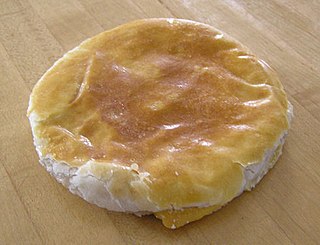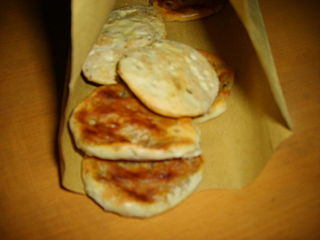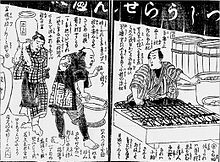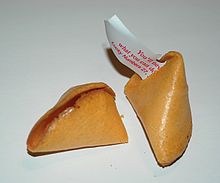
American Chinese cuisine is a cuisine derived from Chinese cuisine that was developed by Chinese Americans. The dishes served in many North American Chinese restaurants are adapted to American tastes and often differ significantly from those found in China.

A cookie or biscuit is a baked snack or dessert that is typically small, flat, and sweet. It usually contains flour, sugar, egg, and some type of oil, fat, or butter. It may include other ingredients such as raisins, oats, chocolate chips, or nuts.

Tahini or tahina is a Levantine condiment made from toasted ground sesame. Its more commonly eaten variety comes from hulled sesame, but unhulled seeds can also be used for preparing it. The latter variety has been described as slightly bitter, but more nutritious. It is served by itself or as a major ingredient in hummus, baba ghanoush, and halva.

Pocky is a Japanese sweet snack food produced by the Ezaki Glico food company. Pocky was first sold in 1966, and was invented by Yoshiaki Koma. It consists of coated biscuit sticks. It was named after the Japanese onomatopoeic word pokkiri (ポッキリ), which is supposed to resemble the sound of the snack being cracked.

A sweetheart cake or wife cake or marriage pie is a traditional Chinese cake with a thin crust of flaky pastry, made with a filling of winter melon, almond paste, and sesame, and spiced with five spice powder. "Wife cake" is the translation of 老婆饼 from Chinese, and although the meaning is "wife", the literal translation is "old lady cake", paralleling the colloquial usage of "old lady" for "wife" in English. In Hong Kong, it is known as a specialty of the Yuen Long District.

Cha chaan teng, often called a Hong Kong-style cafe or diner in English, is a type of restaurant that originated in Hong Kong. Cha chaan teng are commonly found in Hong Kong, Macau, and parts of Guangdong. Due to the waves of mass migrations from Hong Kong in the 1980s, they are now established in major Chinese communities in Western countries such as Australia, Canada, the United Kingdom, and the United States. Likened to a greasy spoon cafe or an American diner, cha chaan tengs are known for eclectic and affordable menus, which include dishes from Hong Kong cuisine and Hong Kong-style Western cuisine. They draw comparisons to Western cafés due to their casual settings, as well as menus revolving around coffee and tea.

Mantou, often referred to as Chinese steamed bun, is a white and soft type of steamed bread or bun popular in northern China. Folk etymology connects the name mantou to a tale about Zhuge Liang.
Makoto Hagiwara was a Japanese-born American landscape designer responsible for the maintenance and expansion of the Japanese Tea Garden at Golden Gate Park in San Francisco, California, from 1895 until his death in 1925. Hagiwara is often credited with the invention of the fortune cookie in California.

Dragon's beard candy or Chinese cotton candy or Longxusu is a handmade traditional art of China. It is a traditional Chinese confectionary similar to floss halva or Western cotton candy, which can be found in many Chinese communities. Dragon's beard candy was initially created in China, but soon spread in popularity in other parts of East Asia and South East Asia, becoming a regional delicacy in South Korea in the 1990s, and Singapore in the 1980s, as well as more recently in Canada, and the United States.

The Japanese Tea Garden in San Francisco, California, is a popular feature of Golden Gate Park, originally built as part of a sprawling World's Fair, the California Midwinter International Exposition of 1894. Though many of its attractions are still a part of the garden today, there have been changes throughout the history of the garden that have shaped it into what it is today.

Bing is a wheat flour-based Chinese food with a flattened or disk-like shape. These foods may resemble the flatbreads, pancakes, pies and unleavened dough foods of non-Chinese cuisines. Many of them are similar to the Indian roti, French crêpes, Salvadoran pupusa, or Mexican tortilla, while others are more similar to cakes and cookies.

Kompia or kompyang is a bread product that originates from Fuzhou, the capital city of Fujian Province of China as well as Fuqing. It is popular in Fujian and has spread to other areas including the Ryukyus, Taiwan, and parts of Southeast Asia including Indonesia and the Malaysian towns of Sitiawan, Sibu, Ayer Tawar, Sarikei, Bintangor and other places where the dominant Chinese community is of Fuzhou and Fuqing ancestry.

Fuzhou cuisine is one of the four subsets of Fujian cuisine, which is one of the Eight Great Traditions of Chinese cuisine. Fuzhou cuisine's taste is light compared to other styles, often with a mixed sweet and sour taste. Fuzhou cuisine displays an influence from the neighboring Zhejiang province's cuisine and as the capital of Fujian, Fuzhou has been more influenced by cuisines from Northern China but also have influences native to Fujian. It is traditionally considered the most prestigious subset of Fujian cuisine and was a strong influence on Ryukyuan cuisine in Japan.

Shumai is a type of traditional Chinese dumpling. In Cantonese cuisine, it is usually served as a dim sum snack. In addition to accompanying the Chinese diaspora, a variation of shumai also appears in Japan as shūmai (焼売), and various southeast Asian countries and Australia as dim sim.

Chinese desserts are sweet foods and dishes that are served with tea, along with meals or at the end of meals in Chinese cuisine. The desserts encompass a wide variety of ingredients commonly used in East Asian cuisines such as powdered or whole glutinous rice, sweet bean pastes, and agar. Due to the many Chinese cultures and the long history of China, there are a great variety of desserts of many forms.
Hong Kong Noodle Company is a manufacturer of Chinese noodles, wonton skins, and egg roll wrappers in Los Angeles, United States. It was founded in 1913 by Canton native David Jung, who had immigrated to Los Angeles.

A wonton is a type of Chinese dumpling commonly found across regional styles of Chinese cuisine. It is also spelled wantan or wuntun in transliteration from Cantonese 雲吞 / 云吞 and wenden from Shanghainese 餛飩 / 馄饨. Even though there are many different styles of wonton served throughout China, Cantonese wontons are the most popular in the West due to the predominance of Cantonese restaurants overseas.

Jiaozi are a type of Chinese dumpling. Jiaozi typically consist of a ground meat and/or vegetable filling wrapped into a thinly rolled piece of dough, which is then sealed by pressing the edges together. Finished jiaozi can be boiled, steamed, pan-fried, or deep-fried, and are traditionally served with a black vinegar and sesame oil dip. They can also be served in a soup.





















